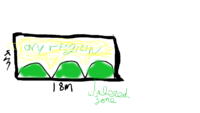eddy2017
Elite Member
- Joined
- Oct 27, 2017
- Messages
- 2,525
Hi, dearest professors, tutors and mere mortals like lev88 says:
I am working on this problem right now. I am attaching a drawing that comes with the problem. It has not bee npainted by me. It comes with it.
A farmer has a rectangle plot with sprinklers along the side. Each of the three water sprinklers covers a semicircle of 3 meters. the region shaded in yellow remains dry. Find the area of the unwatered region to the nearest square meter.
Solution
Given
Length = 18m
Width=4m
Area of the unwatered region=?
Each of the sprinklers covers a semicircle with a radius of 3m.
What I want to do first is to find the area of the whole rectangle. I think that is pretty evident because I have been given length and width and I have a r rectangular plot here.
So,
A= l* w
A=4m * 18m
A=72 m^2
Any hint now will be more than welcomed.
I am working on this problem right now. I am attaching a drawing that comes with the problem. It has not bee npainted by me. It comes with it.
A farmer has a rectangle plot with sprinklers along the side. Each of the three water sprinklers covers a semicircle of 3 meters. the region shaded in yellow remains dry. Find the area of the unwatered region to the nearest square meter.
Solution
Given
Length = 18m
Width=4m
Area of the unwatered region=?
Each of the sprinklers covers a semicircle with a radius of 3m.
What I want to do first is to find the area of the whole rectangle. I think that is pretty evident because I have been given length and width and I have a r rectangular plot here.
So,
A= l* w
A=4m * 18m
A=72 m^2
Any hint now will be more than welcomed.

